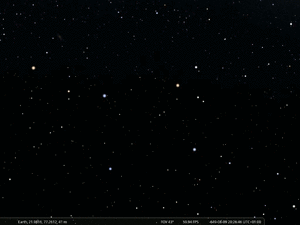Purva Bhadrapada: Difference between revisions
No edit summary |
No edit summary |
||
| (3 intermediate revisions by the same user not shown) | |||
| Line 1: | Line 1: | ||
{{DISPLAYTITLE:}} |
{{DISPLAYTITLE:Purvābhādra (पूर्व भाद्रपदा)}} |
||
[[File:25 PurvaBhadrapada draw.png|thumb|Purva Bhadapadra, the 25th nakshatra asterism, as depicted in temples.]] |
[[File:25 PurvaBhadrapada draw.png|thumb|Purva Bhadapadra, the 25th nakshatra asterism, as depicted in temples.]] |
||
[[File:25+26 naks stellarium.gif|thumb|The 25th and 26th nakshatra mapped to the Stellarium star chart, SMH for WGSN 2025. P. Bhadrapada is the western (right) one. ]] |
[[File:25+26 naks stellarium.gif|thumb|The 25th and 26th nakshatra mapped to the Stellarium star chart, SMH for WGSN 2025. P. Bhadrapada is the western (right) one. ]] |
||
Purvābhādra (पूर्व भाद्रपदा), "the first of the blessed feet", is an Indian name, used by the Indian Vedic tradition. Most of these names are roughly 3000 years old. They pre-date Hinduism but were taken over by it. typically identified with α and β Pegasi. |
|||
==Etymology and History== |
==Etymology and History== |
||
'''Name Variants''' |
|||
| ⚫ | |||
| ⚫ | The term literally means "the first of the blessed feet", and together with [[Uttara Bhadrapada]], the latter of the blessed feet, it forms a super-constellation. Yet, the two asterism are depicted in totally different ways in temples. This one |
||
* Purvābhādra |
|||
| ⚫ | |||
* Purva Bhadrapada |
|||
* Ajanghri, |
|||
* Ajaikapada, |
|||
* Pragbhadra |
|||
| ⚫ | |||
| ⚫ | |||
| ⚫ | The term literally means "the first of the blessed feet", and together with [[Uttara Bhadrapada]], the latter of the blessed feet, it forms a super-constellation. Yet, the two asterism are depicted in totally different ways in temples. This one shows a quadrilateral (like a table) with two stars marked. It is likely identified with the stars in the area of western [[Pegasus]], although we can't know which ones exactly. |
||
| ⚫ | |||
The two Bhadrapada asterisms equal the Chinese Eastern Wall (壁宿) and Encampment (Ying Shi, Mansion), which also form lunar mansions. |
|||
| ⚫ | |||
| ⚫ | |||
| ⚫ | |||
| ⚫ | |||
| ⚫ | |||
| ⚫ | |||
| ⚫ | |||
| ⚫ | |||
==References== |
|||
| ⚫ | |||
[[Category:Indian]] |
|||
[[Category:Indian]] [[Category:Asterism]] [[Category:Constellation]][[Category:Eurasia]][[Category:South Asian]] |
|||
[[Category:Asterism]] |
|||
[[Category:Constellation]] |
|||
[[Category:Eurasia]] |
|||
[[Category:South Asian]] |
|||
Latest revision as of 07:00, 14 October 2025
Purvābhādra (पूर्व भाद्रपदा), "the first of the blessed feet", is an Indian name, used by the Indian Vedic tradition. Most of these names are roughly 3000 years old. They pre-date Hinduism but were taken over by it. typically identified with α and β Pegasi.
Etymology and History
Name Variants
- Purvābhādra
- Purva Bhadrapada
- Ajanghri,
- Ajaikapada,
- Pragbhadra
Origin of Constellation
The term literally means "the first of the blessed feet", and together with Uttara Bhādrapada (उत्तर भाद्रपदा), the latter of the blessed feet, it forms a super-constellation. Yet, the two asterism are depicted in totally different ways in temples. This one shows a quadrilateral (like a table) with two stars marked. It is likely identified with the stars in the area of western Pegasus, although we can't know which ones exactly.
The two Bhadrapada asterisms equal the Chinese Eastern Wall (壁宿) and Encampment (Ying Shi, Mansion), which also form lunar mansions.
Transfer and Transformation of the Constellation
Mythology
mnemonic tales and cultural significance
Weblinks
References
- References (general)






